Kingston Hospital
Galsworthy Road, Kingston-on-Thames, Surrey KT2 7QB
Medical dates:
Medical character:
Acute
In
1839 a new workhouse was built by the Kingston Union in Coombe Road in
a field purchased from Mr. Dickens, a local farmer, to replace the
overcrowded one in London Road.
The large neo-Tudor building could accommodate 320 inmates. The local ratepayers, who had footed the bill of £5,548 for its construction, called it the 'Grand Palace' (although conditions for the paupers inside belied the grand exterior). A well was bored to a depth of 90 ft (27 metres) to supply the institution with water (this survived until 1919).
In 1843 an infirmary to accommodate between 80 and 100 patients was approved to be built for £849 to the northeast of the workhouse. The building works were subjected to continual delays (two workmen had been sacked for 'disgusting conduct' on the site in March 1844) and in April the exasperated Guardians threatened to impose a £10 penalty on the contractors for each week of delay. A deadline of 23rd July was finally imposed, and broken. The contractors were sacked and the Guardians employed their own builders to finish the task.
The H-shaped infirmary, built of brick with York stone facings, was finally completed in September 1844, the Guardians withholding part of the contractor's fee. A medical officer was appointed, but the Guardians baulked at the idea of paying a nurse £10 a year, and crude nursing care was provided instead by the workhouse inmates. The infirmary was a cheerless building and had no fireplaces. The medical officer, Dr Cox, pleaded with the Guardians to provide stoves and fireplaces against the bitter cold, and a professional nurse. Nothing happened and, in 1846, Dr Cox was still requesting that a competent nurse be appointed, as the current ones were "untrustworthy" and "unfit for office". The Guardians finally agreed to appoint a nurse at an annual salary of £16 plus double food and rations. In the event, no candidates applied. The low pay, poor living conditions in the infirmary and hazardous work dealing with "lunatics and dangerous idiots" proved to be a successful deterrent to any nurses during the 19th century.
Almost as soon as it had been built, the Infirmary proved inadequate, and patients often had to lie on the floor because of the lack of beds. By the 1860s the workhouse contained 344 inmates, of whom 260 - more than two-thirds - needed medical care.
In 1868 a larger infirmary was built to the southwest of the workhouse at a cost of £7000. The local newspaper declared it to be "a decided ornament to the locality" - the last word in modernity. The infirmary had eight wards, each containing 10 beds, and a 'dead house' in the basement. The wards had gas lighting and were heated by open fireplaces; windows on both sides of the wards ensured proper ventilation. The Infirmary was soon filled and was eventually extended in 1894. By this time, however, it was evident that yet another infirmary was needed.
In 1897 the Guardians agreed that a new male infirmary, Nurses' Home and porter's lodge should be built to the north of the workhouse, the total cost to be £18,200. Foundations were laid but, with ensuing difficulties and disagreements, the buildings were not completed until 1899, by which time the costs has risen to £22,832. The new purpose-built Nurses' Home, which had been completed in 1898, had 31 bedrooms, with communal rooms for reading, sitting and dining. The Guardians, tired of a constant stream of resignations, decided to attract a "better class of nurse". The annual salary for a charge nurse was increased to £33, while assistant nurses and those looking after imbeciles earned £27. Nurses caring for the infirm received £20. These salaries included the time-honoured beer money (paid in lieu of the beverage itself). The medical officer for the workhouse received the same salary as his predecessor, unchanged since 1847, despite the fact that the bed numbers had increased from 50 to 300. (It is not known what his salary was, but the medical officer for the Maldon district received £40 per annum, unchanged since 1886.)
The new infirmary had 132 beds. It was described as "one of the most beautifully fitted institutions of its kind" and was heated by 'warm air stoves and hot water coils'. The 15 wards had balconies, which enabled the patients to enjoy the open air (these were later enclosed). The building had a central tower which contained a reserve water tank "at an altitude sufficient to serve all parts of the house".
Treatment for medical ailments would have been limited, but beer and wine were considered beneficial. Nursing mothers received a pint of beer daily, and some patients received a glass of port as part of their treatment well into the 20th century.
In 1902 the infirmary was separated from the workhouse and became the Kingston Infirmary. Its medical staff consisted of a resident physician who worked under the direction of a part-time Medical Officer. There were 47 nurses.
By 1912 the Guardians realized that the single full-time doctor was seriously overworked and another was appointed (he later became the first Medical Superintendent in 1919).
During WW1 the Infirmary provided care for injured servicemen, with 150 beds reserved for them, although only 100 were used at first. The surgical equipment was much improved as a result of this. The Infirmary was affiliated to the Horton (County of London) War Hospital as a Class B hospital on 1st August 1915. In 1918 the military bed complement was extended to 150 beds, largely used as an adjunct to the Eye Department of Horton Hospital. The military wards closed on 22nd January 1919.
After the war the Infirmary began to treat local residents who were on long waiting lists for treatment at the general hospitals in the area.
In 1920 the Infirmary was renamed the Kingston & District Hospital, thus escaping the pejorative word 'infirmary', inextricably linked with the Poor Law and pauperism. A larger Nurses' Home for 110 nurses was built in 1926 on the western side of the site, with its entrance in Wolverton Avenue. It was formally opened in 1928 by the Duchess of York (who later became Queen Elizabeth the Queen Mother).
In 1930 the Boards of Guardians were abolished and replaced by Public Assistant Committees. The workhouse was renamed the Kingston Central Relief Institution. By the 1930s the incidence of road traffic accidents had greatly increased - from 16 cases in 1920 to 240 in 1930 - and the Hospital installed a modern operating theatre. The Medical Superintendent performed most of the operations (800 in 1930), as well as running the 600-bedded Hospital. In addition to him, there were now three staff doctors and 107 nurses. A Massage and Electrical Department had been established. Conditions had improved for patients, with each bed equipped with a wireless set (radio). By 1936 plans had been drawn up for the rebuilding of the Hospital, but the outbreak of WW2 in 1939 delayed in the scheme.
During the war the Out-Patients Department was destroyed by bombs, but the work carried on in two wards.
The Hospital joined the NHS in 1948 under the control of the Kingston and Long Grove Hospital Management Committee, part of the South West Metropolitan Regional Hospital Board. In 1949 the Institution was transferred to the Board and integrated into the Hospital. The Board began a four-phase plan to develop the site as a modern hospital.
In 1959, when the Hospital had 534 beds, work began on a new Out-Patients Department, which was officially opened by Princess Alexandra in 1963. A new Medical Centre, built in 1962, was opened by the then Minister of Health, Enoch Powell. A new boiler house and Works Department were built in 1968 on land adjoining the Galsworthy and Coombe Roads. In 1969 a short-stay psychiatric unit, Kenley Ward, was opened by Prof. Sir Max Rosenheim, President of the Royal College of Physicians.
Following a major reorganisation of the NHS in 1974 the Hospital came under the control of the Kingston and Richmond District Health Authority, part of the South West Thames Regional Health Authority.
The second phase of construction began in the 1970s. The Esher Wing, a 7-storey building containing the main suite of 8 operating theatres and beds for acute medical and orthopaedic cases, opened in 1976.
After another major reorganisation of the NHS in 1982, the Hospital came under the authority of the Kingston and Esher District Health Authority.
In 1991, with the introduction of the 'marketplace' system of purchaser and provider, the Hospital formed the Kingston Hospital NHS Trust.
In 1992 the Bernard Meade Wing was officially opened by Princess Alexandra. In the early 1990s an appeal was launched by the League of Friends to raise money for a CT scanner. Over £1m was collected and provided funds for the scanner and a building to house it in - the Rowan Bentall Wing - which was officially opened by Princess Alexandra in 1994. In 1995 the Maternity and Day Surgery buildings were completed. In the same year the Royal Eye Hospital moved to the site from the opposite side of Coombe Road, becoming the Royal Eye Unit.
In 1998 most of the medical and elderly services transferred from Queen Mary's Hospital in Roehampton, along with more than 475 members of staff (the Roehampton Wing had been built in a record 19 weeks).
In 1998 the original Nurses' Home, built in 1897, was demolished. Its site is now a car park.
In 2002 a new Accident & Emergency Department opened, double the size of its predecessor. In 2007 the £33m PFI-funded Kingston Surgical Centre with 100 beds was opened by the Secretary of State for Health, Alan Johnson. The 5-storey building contains surgical and gynaecological wards previously housed in the Roehampton Wing, a Physiotherapy Department, an Education Centre and a restaurant.
The large neo-Tudor building could accommodate 320 inmates. The local ratepayers, who had footed the bill of £5,548 for its construction, called it the 'Grand Palace' (although conditions for the paupers inside belied the grand exterior). A well was bored to a depth of 90 ft (27 metres) to supply the institution with water (this survived until 1919).
In 1843 an infirmary to accommodate between 80 and 100 patients was approved to be built for £849 to the northeast of the workhouse. The building works were subjected to continual delays (two workmen had been sacked for 'disgusting conduct' on the site in March 1844) and in April the exasperated Guardians threatened to impose a £10 penalty on the contractors for each week of delay. A deadline of 23rd July was finally imposed, and broken. The contractors were sacked and the Guardians employed their own builders to finish the task.
The H-shaped infirmary, built of brick with York stone facings, was finally completed in September 1844, the Guardians withholding part of the contractor's fee. A medical officer was appointed, but the Guardians baulked at the idea of paying a nurse £10 a year, and crude nursing care was provided instead by the workhouse inmates. The infirmary was a cheerless building and had no fireplaces. The medical officer, Dr Cox, pleaded with the Guardians to provide stoves and fireplaces against the bitter cold, and a professional nurse. Nothing happened and, in 1846, Dr Cox was still requesting that a competent nurse be appointed, as the current ones were "untrustworthy" and "unfit for office". The Guardians finally agreed to appoint a nurse at an annual salary of £16 plus double food and rations. In the event, no candidates applied. The low pay, poor living conditions in the infirmary and hazardous work dealing with "lunatics and dangerous idiots" proved to be a successful deterrent to any nurses during the 19th century.
Almost as soon as it had been built, the Infirmary proved inadequate, and patients often had to lie on the floor because of the lack of beds. By the 1860s the workhouse contained 344 inmates, of whom 260 - more than two-thirds - needed medical care.
In 1868 a larger infirmary was built to the southwest of the workhouse at a cost of £7000. The local newspaper declared it to be "a decided ornament to the locality" - the last word in modernity. The infirmary had eight wards, each containing 10 beds, and a 'dead house' in the basement. The wards had gas lighting and were heated by open fireplaces; windows on both sides of the wards ensured proper ventilation. The Infirmary was soon filled and was eventually extended in 1894. By this time, however, it was evident that yet another infirmary was needed.
In 1897 the Guardians agreed that a new male infirmary, Nurses' Home and porter's lodge should be built to the north of the workhouse, the total cost to be £18,200. Foundations were laid but, with ensuing difficulties and disagreements, the buildings were not completed until 1899, by which time the costs has risen to £22,832. The new purpose-built Nurses' Home, which had been completed in 1898, had 31 bedrooms, with communal rooms for reading, sitting and dining. The Guardians, tired of a constant stream of resignations, decided to attract a "better class of nurse". The annual salary for a charge nurse was increased to £33, while assistant nurses and those looking after imbeciles earned £27. Nurses caring for the infirm received £20. These salaries included the time-honoured beer money (paid in lieu of the beverage itself). The medical officer for the workhouse received the same salary as his predecessor, unchanged since 1847, despite the fact that the bed numbers had increased from 50 to 300. (It is not known what his salary was, but the medical officer for the Maldon district received £40 per annum, unchanged since 1886.)
The new infirmary had 132 beds. It was described as "one of the most beautifully fitted institutions of its kind" and was heated by 'warm air stoves and hot water coils'. The 15 wards had balconies, which enabled the patients to enjoy the open air (these were later enclosed). The building had a central tower which contained a reserve water tank "at an altitude sufficient to serve all parts of the house".
Treatment for medical ailments would have been limited, but beer and wine were considered beneficial. Nursing mothers received a pint of beer daily, and some patients received a glass of port as part of their treatment well into the 20th century.
In 1902 the infirmary was separated from the workhouse and became the Kingston Infirmary. Its medical staff consisted of a resident physician who worked under the direction of a part-time Medical Officer. There were 47 nurses.
By 1912 the Guardians realized that the single full-time doctor was seriously overworked and another was appointed (he later became the first Medical Superintendent in 1919).
During WW1 the Infirmary provided care for injured servicemen, with 150 beds reserved for them, although only 100 were used at first. The surgical equipment was much improved as a result of this. The Infirmary was affiliated to the Horton (County of London) War Hospital as a Class B hospital on 1st August 1915. In 1918 the military bed complement was extended to 150 beds, largely used as an adjunct to the Eye Department of Horton Hospital. The military wards closed on 22nd January 1919.
After the war the Infirmary began to treat local residents who were on long waiting lists for treatment at the general hospitals in the area.
In 1920 the Infirmary was renamed the Kingston & District Hospital, thus escaping the pejorative word 'infirmary', inextricably linked with the Poor Law and pauperism. A larger Nurses' Home for 110 nurses was built in 1926 on the western side of the site, with its entrance in Wolverton Avenue. It was formally opened in 1928 by the Duchess of York (who later became Queen Elizabeth the Queen Mother).
In 1930 the Boards of Guardians were abolished and replaced by Public Assistant Committees. The workhouse was renamed the Kingston Central Relief Institution. By the 1930s the incidence of road traffic accidents had greatly increased - from 16 cases in 1920 to 240 in 1930 - and the Hospital installed a modern operating theatre. The Medical Superintendent performed most of the operations (800 in 1930), as well as running the 600-bedded Hospital. In addition to him, there were now three staff doctors and 107 nurses. A Massage and Electrical Department had been established. Conditions had improved for patients, with each bed equipped with a wireless set (radio). By 1936 plans had been drawn up for the rebuilding of the Hospital, but the outbreak of WW2 in 1939 delayed in the scheme.
During the war the Out-Patients Department was destroyed by bombs, but the work carried on in two wards.
The Hospital joined the NHS in 1948 under the control of the Kingston and Long Grove Hospital Management Committee, part of the South West Metropolitan Regional Hospital Board. In 1949 the Institution was transferred to the Board and integrated into the Hospital. The Board began a four-phase plan to develop the site as a modern hospital.
In 1959, when the Hospital had 534 beds, work began on a new Out-Patients Department, which was officially opened by Princess Alexandra in 1963. A new Medical Centre, built in 1962, was opened by the then Minister of Health, Enoch Powell. A new boiler house and Works Department were built in 1968 on land adjoining the Galsworthy and Coombe Roads. In 1969 a short-stay psychiatric unit, Kenley Ward, was opened by Prof. Sir Max Rosenheim, President of the Royal College of Physicians.
Following a major reorganisation of the NHS in 1974 the Hospital came under the control of the Kingston and Richmond District Health Authority, part of the South West Thames Regional Health Authority.
The second phase of construction began in the 1970s. The Esher Wing, a 7-storey building containing the main suite of 8 operating theatres and beds for acute medical and orthopaedic cases, opened in 1976.
After another major reorganisation of the NHS in 1982, the Hospital came under the authority of the Kingston and Esher District Health Authority.
In 1991, with the introduction of the 'marketplace' system of purchaser and provider, the Hospital formed the Kingston Hospital NHS Trust.
In 1992 the Bernard Meade Wing was officially opened by Princess Alexandra. In the early 1990s an appeal was launched by the League of Friends to raise money for a CT scanner. Over £1m was collected and provided funds for the scanner and a building to house it in - the Rowan Bentall Wing - which was officially opened by Princess Alexandra in 1994. In 1995 the Maternity and Day Surgery buildings were completed. In the same year the Royal Eye Hospital moved to the site from the opposite side of Coombe Road, becoming the Royal Eye Unit.
In 1998 most of the medical and elderly services transferred from Queen Mary's Hospital in Roehampton, along with more than 475 members of staff (the Roehampton Wing had been built in a record 19 weeks).
In 1998 the original Nurses' Home, built in 1897, was demolished. Its site is now a car park.
In 2002 a new Accident & Emergency Department opened, double the size of its predecessor. In 2007 the £33m PFI-funded Kingston Surgical Centre with 100 beds was opened by the Secretary of State for Health, Alan Johnson. The 5-storey building contains surgical and gynaecological wards previously housed in the Roehampton Wing, a Physiotherapy Department, an Education Centre and a restaurant.
Present status (June 2008)
The workhouse buildings have been demolished but the 1868 infirmary building survives as the Regent Wing.
The Hospital has reinvented itself as a modern up-to-date health care facility and currently has 601 beds.
Update (December 2009)
In July 2008 a new cancer treatment block - the Sir William Rous Unit - was opened by Princess Alexandra. Named after a former Chairman of the Hospital, who died of cancer in 1999, it had been funded by donations from the cancer charities Kingston Can and Macmillan Cancer Support, and the Royal Marsden Hospital.
The Wolverton Centre, for sexual health, opened in a new building in November 2008.
The workhouse buildings have been demolished but the 1868 infirmary building survives as the Regent Wing.
The Hospital has reinvented itself as a modern up-to-date health care facility and currently has 601 beds.
Update (December 2009)
In July 2008 a new cancer treatment block - the Sir William Rous Unit - was opened by Princess Alexandra. Named after a former Chairman of the Hospital, who died of cancer in 1999, it had been funded by donations from the cancer charities Kingston Can and Macmillan Cancer Support, and the Royal Marsden Hospital.
The Wolverton Centre, for sexual health, opened in a new building in November 2008.
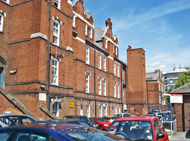
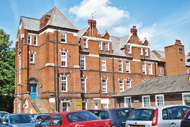
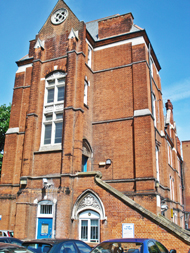
The 1868 infirmary building is now the Regent Wing.
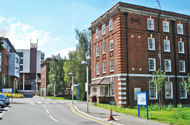
The 1928 Nurses' Home is now Vera Brown House, an administration block. It is named after a nurse who worked at the Hospital during WW1.
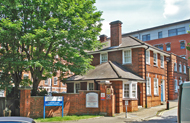
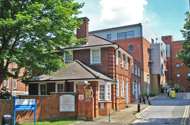
The Nurses' Home and lodge on Wolverton Avenue are due to be demolished and replaced by new staff housing, built in partnership with a local housing association.
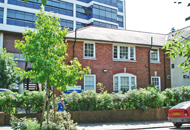

The Maple Children's Unit provided respite and development care for children with disablity and complex health needs. It closed in September and the service was relocated to The Moor Lane Centre in Chessington.
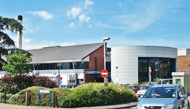
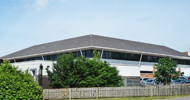
The Maternity and Day Surgery Wing.

The main entrance in the Bernard Meade Wing.
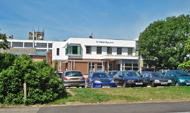
The Sir William Rous Unit.
(Author unstated) 1928 Nursing echoes. British Journal of Nursing (April), 82.
(Author unstated) 1928 An exchange of gifts. British Journal of Nursing (May), 108.
Lord JR 1920 The Story of the Horton (County of London) War Hospital, Epsom - Its Inception and Work and Some Reflections. London, Heinemann.
Sampson J 1998 Kingston Hospital's Victorian workhouse past. News Shopper, 4th July.
Sampson J 2004 New infirmary as Luck would have it. Surrey Comet, 13th August.
https://en.wikipedia.org
https://moderngov.kingston.gov.uk
www.facebook.com
www.getsurrey.co.uk
www.hospitalmanagement.net
www.kingstonhospital.nhs.uk
www.workhouses.org
Return to home page